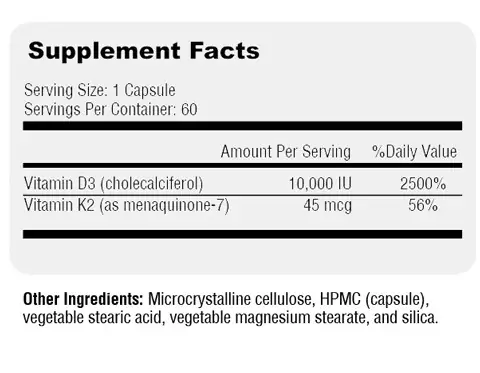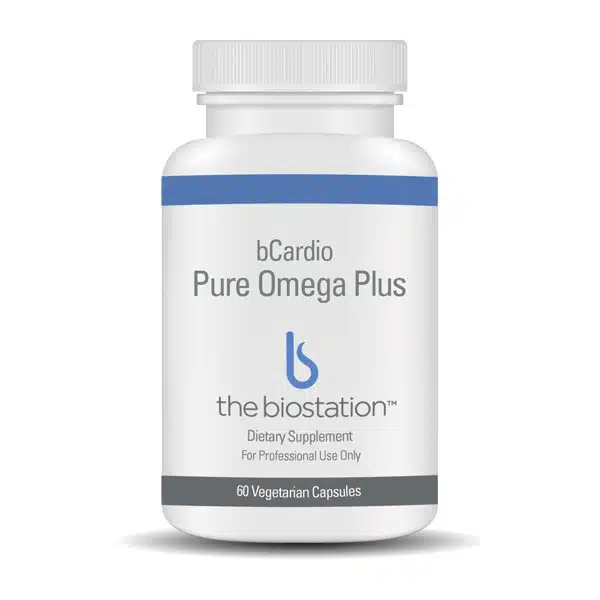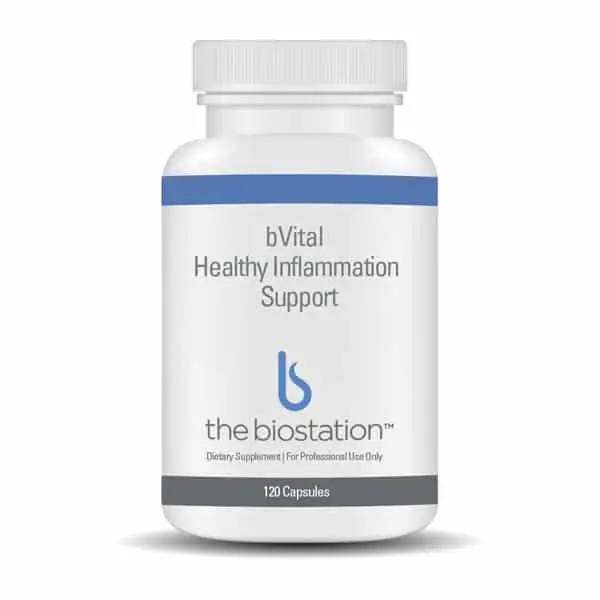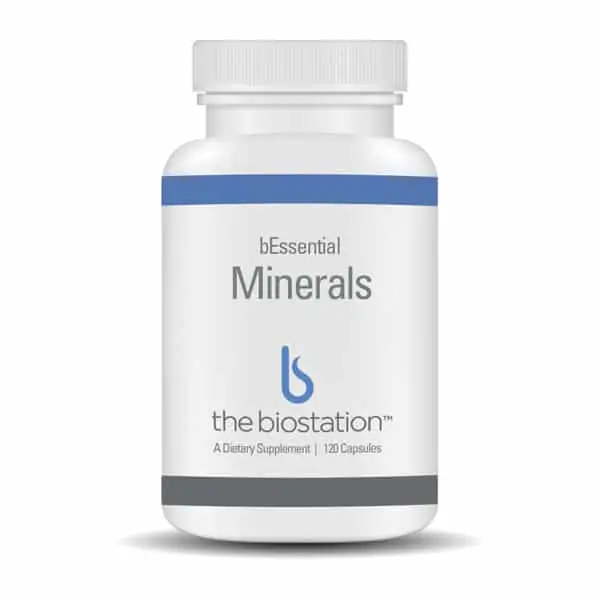bCardio K2D3
Supports cardiovascular and bone health.
- Supports Bone Health by Promoting Carboxylation of Bone Proteins*
- Supports Cardiovascular Health by Affecting Arterial Calcium Deposits*
- Supports Healthy Blood Clotting*
- Supports Bone Strength and Dental Health*
- Supports Modulation of Immune Function*
- Supports Healthy Cell Differentiation*
- Supports Neurologic and Cognitive Health*
- Supports Musculoskeletal Comfort*
- Supports Cardiovascular Health and Healthy Blood Sugar Metabolism*
- Supports Vitamin D Repletion in Cases of Dietary Deficiency, Limited Sunlight Exposure, or Use of Depleting Therapies*
Naturally occurring vitamin K is found as either K1 (phylloquinone), which is derived from food sources such green leafy vegetables, or K2 (menaquinones). Menaquinones are designated as MK-n, where n denotes the length of the molecule’s aliphatic side chain. Menaquinones are synthesized by bacteria and can be obtained from animal-based and fermented foods. Structural differences between K1 and K2 impact their bioavailability and bioactivity. Furthermore, among menaquinones, menaquinone-7 (MK-7), with its longer side chain, is very hydrophobic. Compared to K1, MK-7’s physiochemical properties make it highly transportable by plasma lipoproteins, increase its extrahepatic (bones, arteries, etc.) availability, and produce its long half-life.
Absorption of K1 from food can be limited due to its membrane-bound nature and the individual consumer’s digestive and absorptive variability. Moreover, adequate consumption of foods high in K2 can be challenging. Therefore, dietary supplementation is an important option. In addition, research suggests that higher levels of menaquinones are needed than were previously thought. Supplementary vitamin K can be found in three forms: synthetic K1; MK-4, which is structurally similar to K1; and natural, long-chain MK-7. The biostation provides MK-7 as Vitamk7™, a naturally derived and solvent-free vitamin K2 that has been obtained through a patent-granted biofermentation process of Bacillus subtilis natto cultures.*
While vitamin D3 (cholecalciferol) is made in the skin when 7-dehydrocholesterol reacts with sunlight, many things affect the degree to which this biosynthesis occurs, including time of day, seasons, location, smog/pollution, clothing, shade of skin (darker skin requires more sun), and sunscreen use. Low-cholesterol diets and certain cholesterol therapies can also affect vitamin D formation. By some estimates, one billion people worldwide have vitamin D deficiency or insufficiency.[1] Reversing deficiency and maintaining optimal serum vitamin D levels beneficially impacts biochemistry and numerous body systems; this is largely because calcitriol—the metabolic product of vitamin D—is a secosteroid hormone that targets over 200 genes in a wide variety of tissues.[2,3] As the research demonstrates, vitamin D is clearly imperative for the development, growth, and maintenance of a healthy body from gestation to senescence.*
Category
- brain boosters
- heart health
- immune support
- thyroid support
- total wellness
MK-7 Bioavailability Increases Extrahepatic Tissue Utilization
Schurgers et al conducted human studies to compare the in vivo properties of orally administered K1 and MK-7. The results supported better bioavailability and utilization of MK-7. Expressed as AUC96, MK-7 demonstrated a six-fold better half-life, a seven- to eight-fold higher dose-response level, and a three times higher carboxylated to uncarboxylated osteocalcin ratio (cOC:ucOC†). Furthermore, on a molar basis, MK-7 is a three-to-four times more potent antidote for oral anticoagulation than is K1. Researchers note that, aside from sensitive individuals, “MK-7 supplements containing more than 50 mcg/d may interfere with oral anticoagulant treatment, whereas doses of at least 50 mcg are not likely to affect the INR value in a relevant way.”[2] Nonetheless, practitioners should closely monitor patients taking anticoagulants.*
While studies on the absorption and bioavailability of MK-4 at nutritional levels (i.e., doses of 500 mcg/d or lower) suggest less efficacy compared to longer-chain menaquinones at similar doses,[4] this remains subject to debate. It is possible that rapid uptake of MK-4 could account for its observed lack of detection in serum after oral administration,[5] but more studies are needed for clarification.*
Bone Benefits
Among the dietary factors critical to bone health, vitamin K has emerged as a key player. Vitamin K is believed to be necessary for bone mineralization. Through carboxylation, vitamin K activates osteocalcin, the protein needed to bind calcium to the mineral matrix in bone.[6] Several studies have demonstrated the efficacy of MK-7 (e.g., doses of 45-90 mcg/d) to increase osteocalcin carboxylation and to increase the cOC:ucOC ratio. A high cOC:ucOC ratio is associated with bone health.[1,2,4] A recent in vitro study also showed an osteogenic effect of MK-7 administration on human mesenchymal cell differentiation.[6] In addition, the vitamin may protect bone integrity by reducing the synthesis of prostaglandin E2 or interleukin-6 by osteoclasts.[7] Animal and human studies have demonstrated a significant beneficial effect of MK-7 supplementation on bone health.[8-10] Vitamin K and vitamin D share some similar characteristics and are believed to act synergistically.*[11].
The body needs vitamin D to absorb calcium, and the importance of vitamin D in skeletal health and bone density is well established. Although bone density is most often associated with calcium intakes, insufficient vitamin D negatively affects calcium absorption.[3] Without adequate absorption, the body must take calcium from its stores in the skeleton, which weakens existing bone and prevents the formation of strong, new bone. Clinical research shows that taking vitamin D orally with calcium supplements can support healthy bone turnover[4-6], and adequate calcium and vitamin D throughout life—as part of a well-balanced diet—may reduce the risk of osteoporosis.*
Cardiovascular and Other Health Benefits
Vitamin K benefits cardiovascular health by participating in the carboxylation of matrix GLA protein (MGP), a protein regarded to be the most potent inhibitor of arterial calcification. Researchers have demonstrated that supplementation with vitamin K reduces arterial calcium deposits[1,3,12] and that long-term intake of long-chain menaquinones is inversely correlated with calcium accumulation in arteries.*[5] Vitamin K has specific receptor binding sites that allow it to regulate gene activity.[13] Besides its gene-mediating effects upon critical proteins, the vitamin can also bind with the steroid and xenobiotic receptors and influence their expression.[14] In addition, vitamin K also demonstrates antioxidant activity[15]; reduces levels of certain markers, such as acute phase reactants (e.g., C-reactive protein)[16]; and participates in the induction of apoptosis.*[17] †The cOC:ucOC ratio can be used as a determinant of vitamin K status.
The Expanding Roles of Vitamin D
The role of vitamin D in good health continues to expand as the knowledge of this vitamin’s effects on different body systems grows. Research now suggests that optimal serum levels of vitamin D support normal cell differentiation,[3,7] cardiovascular health,[2,3] normal immune function,[8] good balance,[2] healthy mood,[9] normal fetal development,[10] neuronal growth and neurodevelopment,[2,3,10,11] healthy glucose metabolism,[2,3] musculoskeletal comfort,[2,3] periodontal health,[12] and normal intestinal immune responses.[8] Areas of research that have gained momentum over the past several years concern the relationship of vitamin D deficiency or insufficiency to changes in cellular proliferation, changes in fetal brain development, and mental health. [7,10,13-15] Evidence is also mounting that vitamin D supplementation may provide key immune support.*[16-19]
D2, D3, and Metabolites
As previously stated, D3 is the form of vitamin D produced in the skin. D2 (ergocalciferol) is derived from fungal sources by activating ergosterol with ultraviolet light. It is not naturally present in the human body. After vitamin D is formed in the skin or taken orally, it is metabolized into two different substances within the body: calcidiol (25-hydroxyvitamin D) and calcitriol (1,25-dihydroxyvitamin D). Calcidiol is the body’s main storage form of vitamin D, while calcitriol (made from calcidoil) is “activated” vitamin D. Although D2 and D3 are similar biochemically, a recent study reported D3 to be approximately 87% more potent in raising and maintaining serum calcidiol concentrations and in producing two- to threefold greater storage of vitamin D than did equimolar D2.*
Swallow one capsule daily with water, preferably at mealtime, or as directed by your healthcare practitioner. Consult your healthcare practitioner prior to use. Individuals taking other medication should discuss potential interactions with their healthcare practitioner. Consider total vitamin K intake (food and supplements) if you are taking blood-thinning medication. Present studies show that 45 mcg of MK-7 from Vitamk7™ daily is not likely to interfere with blood-thinning medicines. Do not use if tamper seal is damaged.
Wheat, gluten, yeast, soy protein, dairy products, fish, shellfish, peanuts, tree nuts, egg, ingredients derived from genetically modified organisms (GMOs), artificial colors, artificial sweeteners, or artificial preservatives.
*These statements have not been evaluated by the Food and Drug Administration. This product is not intended to diagnose, treat, cure, or prevent any disease.
K2 reference:
1. Brugè F, Bacchetti T, Principi F, et al. Olive oil supplemented with menaquinone-7 significantly affects osteocalcin carboxylation. Br J Nutr. 2011 Oct;106(7):1058-62. [PMID: 21736837]
2. Schurgers LJ, Teunissen KJ, Hamulyák K, et al. Vitamin K-containing dietary supplements: comparison of synthetic vitamin K1 and natto-derived menaquinone-7. Blood. 2007 Apr 15;109(8):3279-83. [PMID: 17158229]
3. Beulens JW, Bots ML, Atsma F, et al. High dietary menaquinone intake is associated with reduced coronary calcification. Atherosclerosis. 2009 Apr;203(2):48993. [PMID: 18722618]
4. Sato T, Schurgers LJ, Uenishi K. Comparison of menaquinone-4 and menaquinone-7 bioavailability in healthy women. Nutr J. 2012 Nov 12;11:93. [PMID: 23140417]
5. Schurgers LJ, Vermeer C. Differential lipoprotein transport pathways of K-vitamins in healthy subjects. Biochim Biophys Acta. 2002 Feb 15;1570(1):27-32.[PMID: 11960685]
6. Gigante A, Brugè F, Cecconi S, et al. Vitamin MK-7 enhances vitamin D3-induced osteogenesis in hMSCs: modulation of key effectors in mineralization and vascularization. J Tissue Eng Regen Med. 2012 Oct 29. [PMID: 23109511]
7. Weber P. Management of osteoporosis: is there a role for vitamin K? Int J Vitam Nutr Res. 1997;67(5):350-56. [PMID: 9350477]
8. Yamaguchi M, Taguchi H, Gao YH, et al. Effect of vitamin K2 (menaquinone-7) in fermented soybean (natto) on bone loss in ovariectomized rats. J Bone Miner Metab. 1999;17(1):23-29. [PMID: 10084398]
9. Knapen MH, Drummen NE, Smit E, et al. Three-year low-dose menaquinone-7 supplementation helps decrease bone loss in healthy postmenopausal women. Osteoporos Int. 2013 Sep;24(9):2499-507. [PMID: 23525894]
10. Kanellakis S, Moschonis G, Tenta R, et al. Changes in parameters of bone metabolism in postmenopausal women following a 12-month intervention period using dairy products enriched with calcium, vitamin D, and phylloquinone (vitamin K(1)) or menaquinone-7 (vitamin K (2)): the Postmenopausal Health Study II. Calcif Tissue Int. 2012 Apr;90(4):251-62. [PMID: 2239252]
11. Bolton-Smith C, McMurdo ME, Paterson CR, et al. Two-year randomized controlled trial of vitamin K1 (phylloquinone) and vitamin D3 plus calcium on the bone health of older women. J Bone Miner Res. 2007 Apr;22(4):509-19. [PMID: 17243866]
12. Geleijnse JM, Vermeer C, Grobbee DE, et al. Dietary intake of menaquinone is associated with a reduced risk of coronary heart disease: the Rotterdam Study. J Nutr. 2004 Nov;134(11):3100-05. [PMID: 15514282]
13. Igarashi M, Yogiashi Y, Mihara M, et al. Vitamin K induces osteoblast differentiation through pregnane X receptor-mediated transcriptional control of the Msx2 gene. Mol Cell Biol. 2007 Nov;27(22):7947-54. [PMID: 17875939]
14. Azuma K, Inoue S. Vitamin K function mediated by activation of steroid and xenobiotic receptor [in Japanese]. Clin Calcium. 2009 Dec;19(12):1770-8. [PMID: 19949268]
15. Vervoort LM, Ronden JE, Thijssen HH. The potent antioxidant activity of the vitamin K cycle in microsomal lipid peroxidation. Biochem Pharmacol. 1997 Oct 15;54(8):871-76. [PMID: 9354587]
16. Shea MK, Booth SL, Massaro JM, et al. Vitamin K and vitamin D status: associations with inflammatory markers in the Framingham Offspring Study. Am J Epidemiol. 2008 Feb 1;167(3):313-20. [PMID: 18006902]
17. Sada E, Abe Y, Ohba R, et al. Vitamin K2 modulates differentiation and apoptosis of both myeloid and erythroid lineages. Eur J Haematol. 2010 Dec;85(6):53848. [PMID: 20887388]
D3 reference:
1. Tsiaras WG, Weinstock MA. Factors influencing vitamin d status. Acta Derm Venereol. 2011 Mar;91(2):115-24. [PMID: 21384086]
2. Cannell JJ, Hollis BW. Use of vitamin D in clinical practice. Altern Med Rev. 2008 Mar;13(1):6-20. [PMID: 18377099]
3. Heany RP. Vitamin D in health and disease. Clin J Am Soc Nephrol. 2008 Sep;3(5):1535-41. [PMID: 18525006]
4. Dawson-Hughes B, Harris SS, Krall EA, et al. Effect of calcium and vitamin D supplementation on bone density in men and women 65 years of age or older. N Engl J Med. 1997;337:670-76. [PMID: 9278463]
5. Papadimitropoulos E, Wells G, Shea B, et al. Meta-analyses of therapies for postmenopausal osteoporosis. VIII: Meta-analysis of the efficacy of vitamin D treatment in preventing osteoporosis in postmenopausal women. Endocr Rev. 2002;23:560-69. [PMID: 12202471]
6. Lips P, Bouillon R, van Schoor NM, et al. Reducing fracture risk with calcium and vitamin D. Clin Endocrinol (Oxf). 2010 Sep;73(3):277-85. [PMID: 20796001]
7. Garland CF, French CB, Baggerly LL, et al. Vitamin d supplement doses and serum 25-hydroxyvitamin d in the range associated with cancer prevention. Anticancer Res. 2011 Feb;31(2):607-11. [PMID: 21378345]
8. Raman M, Milestone AN, Walters JR, et al. Vitamin D and gastrointestinal diseases: inflammatory bowel disease and colorectal cancer. Therap Adv Gastroenterol. 2011 Jan;4(1):49-62. [PMID: 21317994]
9. Humble MB. Vitamin D, light and mental health. J Photochem Photobiol B. 2010 Nov;101(2):142-49. [PMID: 18445674]
10. Grant WB, Soles CM. Epidemiologic evidence supporting the role of maternal vitamin D deficiency as a risk factor for the development of infantile autism. Dermatoendocrinol. 2009 Jul;1(4):223-28. [PMID: 20592795]
11. Currenti SA. Understanding and determining the etiology of autism. Cell Mol Neurobiol. 2010 Mar;30(2):161-71. [PMID: 19774457]
12. Naito M, Miyaki K, Naito T, et al. Association between vitamin D receptor gene haplotypes and chronic periodontitis among Japanese men. Int J Med Sci. 2007 Aug;4(4):216-22. [PMID: 17848979]
13. McGrath JJ, Burne TH, Féron F, et al. Developmental vitamin D deficiency and risk of schizophrenia: a 10-year update. Schizophr Bull. 2010 Nov;36(6):1073- 78. [PMID: 20833696]
14. Gandini S, Boniol M, Haukka J, et al. Meta-analysis of observational studies of serum 25-hydroxyvitamin D levels and colorectal, breast and prostate cancer and colorectal adenoma. Int J Cancer. 2011 Mar;128(6):1414-24. doi: 10.1002/ ijc.25439. [PMID: 20473927]
15. Yin L, Grandi N, Raum E, et al. Meta-analysis: circulating vitamin D and ovarian cancer risk. Gynecol Oncol. 2011 Feb 14. [Epub ahead of print] [PMID: 21324518]
16. Grant WB, Goldstein M, Mascitelli L. Ample evidence exists from human studies that vitamin D reduces the risk of selected bacterial and viral infections. Exp Biol Med (Maywood). 2010 Dec;235(12):1395-96; discussion 1397. [PMID: 21171208]
17. Beard JA, Bearden A, Striker R. Vitamin D and the anti-viral state. J Clin Virol. 2011 Mar;50(3):194-200. [PMID: 21242105]
18. Hertting O, Holm Å, Lüthje P, et al. Vitamin D induction of the human antimicrobial peptide cathelicidin in the urinary bladder. PLoS One. 2010 Dec;5(12):e15580. [PMID: 21179490]
19. Grant WB, Boucher BJ. Requirements for vitamin D across the life span. Biol Res Nurs. 2011 Jan 17. [Epub ahead of print] [PMID: 21242196]
20. Heaney RP, Recker RR, Grote J, et al. Vitamin d3 is more potent than vitamin d2 in humans. J Clin Endocrinol Metab. 2011 Mar;96(3):E447-52. [PMID: 21177785]

 East Delray, Florida
East Delray, Florida West Delray, Florida
West Delray, Florida The Boca Raton, Florida
The Boca Raton, Florida Midtown Miami, Florida
Midtown Miami, Florida Carillon Wellness Resort
Carillon Wellness Resort  Williams Island
Williams Island  Midtown Tampa, Florida
Midtown Tampa, Florida Life Time
Life Time Grand Wailea
Grand Wailea  NOW OPEN
NOW OPEN  COMING SOON
COMING SOON 

